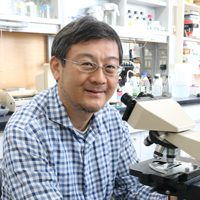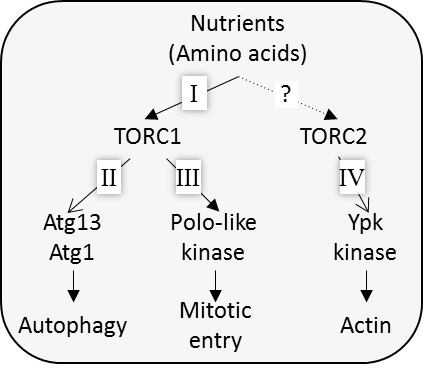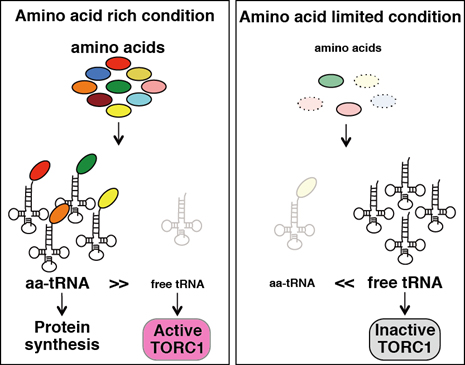
National Institute for Basic Biology





Amino acids are the most important nutrients used in protein building; therefore, their perception is essential for all cells’ existence. The cellular amino acid sensing system employs Tor (target of rapamycin) protein kinase. Tor forms two distinct protein complexes, TORC1 (Tor complex1) and TORC2. On one hand, TORC1 is involved in amino acid sensing, regulation of protein synthesis, the cell cycle, and autophagy. On the other hand, TORC2 is responsible for actin organization and cell integrity. So far, it is not clear whether TORC2 also perceives nutrient signals.
The aim of our research group is to reveal the molecular mechanisms of how TORC1 receives amino acid signals and how the TORC1/2 pathways regulate each phenomenon. We have been studying Tor signaling in the budding yeast Saccharomyces cerevisiae, and have found three novel TOR signaling pathway branches (Figure 1). Recently, we found that tRNA plays a pivotal role in the ability of TORC1 to sense amino acids (Figure 1).

Figure 1. Tor signaling pathway in budding yeast. Our group has found three branches of the Tor pathway.
TORC1 is regulated by amino acids which in themselves are fundamental nutrients. 20 species of amino acids building proteins cannot be interchanged with each other. Therefore, each amino acid must be individually detected by TORC1.
We conducted genetic research and discovered the involvement of (aminoacyl-) tRNA in TORC1 regulation. Biochemical in vitro TORC1 assay also revealed that tRNA directly inhibits TORC1 kinase activity. Reducing cellular tRNA molecules desensitizes TORC1 inactivation by nitrogen starvation in vivo. Based on these results, a TORC1 regulatory model was proposed that contends that free tRNA released from protein synthesis under amino acid starvation inhibits TORC1 activity. Therefore, TORC1 employs a tRNA-mediated mechanism to monitor intracellular amino acids (Figure 2).

Figure 2. A schematic model of how amino acid is sensed by TORC1. Cytosolic free tRNA inactivates TORC1 under amino acid limited condition.
TORC1 negatively regulates autophagy: a protein degradation system induced by nutrient starvation.
We were consequently able to discover the TORC1-mediated regulatory mechanism of autophagy. Under nutrient-rich conditions, TORC1 directly phosphorylates Atg13, a component of the Atg1 kinase complex. Atg1 is a Ser/Thr protein kinase, the activity of which is essential for autophagy and is largely enhanced in response to TORC1 inactivation. Activation of Atg1 requires formation of the Atg1 complex. Phosphorylation of Atg13 by TORC1 plays a pivotal role in Atg1 complex formation; phosphorylated Atg13 loses its affinity to Atg1 resulting in disassembly of the Atg1 complex and repression of autophagy. On the other hand, dephosphorylation of Atg13 triggers formation of the Atg1 complex, activation of Atg1 kinase, and consequently induction of autophagy.
Baba, M., Tomonaga, S., Suzuki, M., Gen, M., Takeda, E., Matsuura, A., Kamada, Y., Baba, N. (2019). A nuclear membrane-derived structure associated with Atg8 is involved in the sequestration of selective cargo, the Cvt complex, during autophagosome formation in yeast. Autophagy 15, 423-437.
Takeda, E., Jin, N., Itakura, E., Kira, S., Kamada, Y., Weisman, L. S., Noda, T., Matsuura, A. (2018). Vacuole-mediated selective regulation of TORC1-Sch9 signaling following oxidative stress. Mol. Biol. Cell 29, 510-522.
Kamada, Y. (2017). Novel tRNA function in amino acid sensing of yeast Tor complex1. Genes to Cells 22, 135-147.
Kamada, Y., Yoshino, K., Kondo, C., Kawamata, T., Oshiro, N., Yonezawa, K., and Ohsumi, Y. (2010). Tor directly controls the Atg1 kinase complex to regulate autophagy. Mol. Cell Biol. 30, 1049-1058.